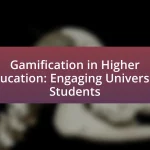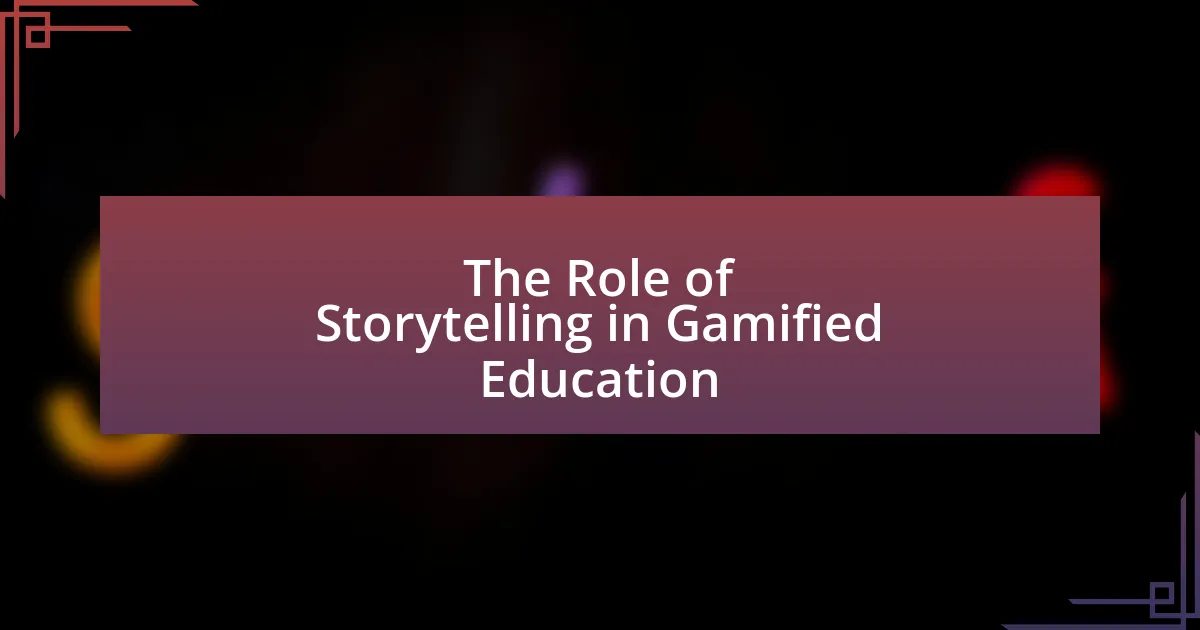The article examines the ethical considerations of gamification in education, focusing on fairness, motivation, and data privacy. It highlights how gamification can enhance student engagement and motivation through game-like elements, while also addressing potential risks such as superficial learning and overemphasis on extrinsic rewards. The discussion includes psychological principles that underpin gamification’s effectiveness, strategies for maintaining educational integrity, and best practices for educators to balance fun and learning. Additionally, it emphasizes the importance of inclusivity and the need to avoid common pitfalls in gamified environments to ensure that educational objectives are met.
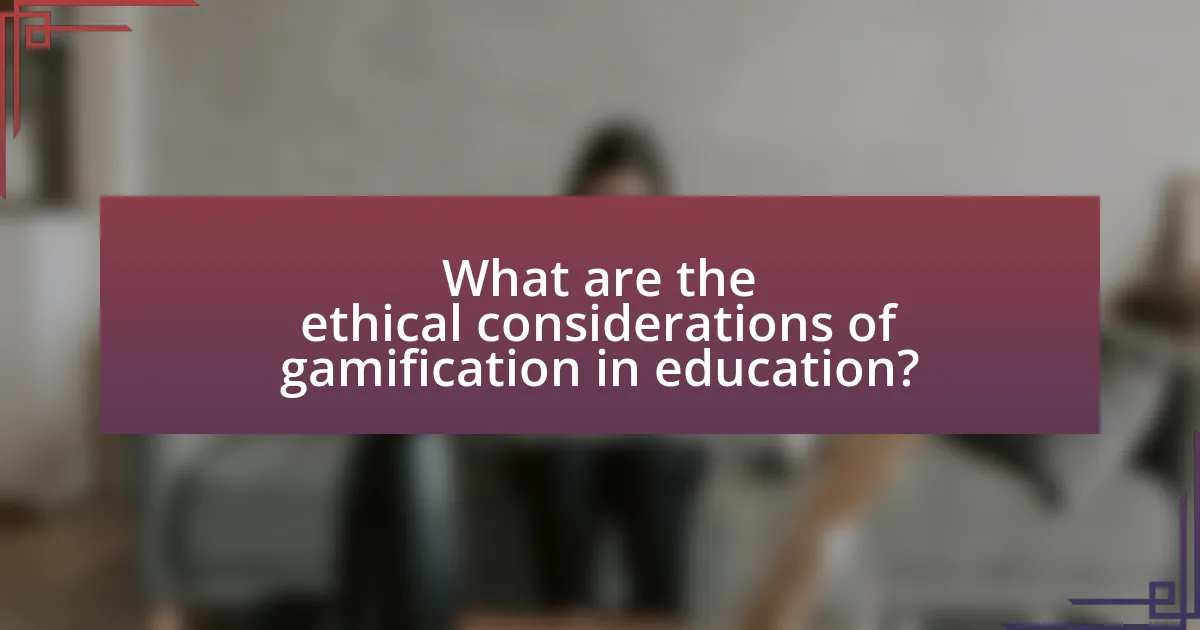
What are the ethical considerations of gamification in education?
The ethical considerations of gamification in education include issues of fairness, motivation, and data privacy. Fairness arises when gamified elements create unequal opportunities for students, potentially disadvantaging those with different backgrounds or learning styles. Motivation can be ethically problematic if gamification leads to extrinsic rewards overshadowing intrinsic learning, which may diminish genuine interest in the subject matter. Data privacy concerns emerge when gamification platforms collect personal information from students, raising questions about consent and the security of sensitive data. These considerations highlight the need for careful implementation of gamification strategies to ensure they enhance educational experiences without compromising ethical standards.
How does gamification impact student engagement and motivation?
Gamification significantly enhances student engagement and motivation by incorporating game-like elements into educational settings. This approach leverages competition, rewards, and interactive challenges to create a more stimulating learning environment. Research indicates that gamified learning experiences can lead to a 60% increase in student engagement levels, as evidenced by a study conducted by Hamari, Koivisto, and Sarsa in 2014, which found that gamification positively influences user motivation and participation in various contexts, including education. By fostering a sense of achievement and encouraging active participation, gamification effectively motivates students to engage more deeply with the learning material.
What psychological principles underlie gamification’s effectiveness?
Gamification’s effectiveness is primarily underpinned by psychological principles such as motivation, reinforcement, and engagement. Motivation is driven by intrinsic factors, like the desire for mastery and autonomy, and extrinsic factors, such as rewards and recognition. Reinforcement, particularly through positive feedback and rewards, encourages continued participation and effort, as evidenced by B.F. Skinner’s operant conditioning theory, which highlights how behaviors can be shaped through rewards. Engagement is enhanced through elements like challenge and competition, which stimulate the brain’s reward system, making tasks more enjoyable and leading to increased persistence. These principles collectively create an environment that fosters learning and retention, as supported by research indicating that gamified learning experiences can improve student performance and satisfaction.
How can gamification enhance or hinder intrinsic motivation?
Gamification can enhance intrinsic motivation by making learning experiences more engaging and enjoyable, which can lead to increased participation and effort. For instance, incorporating elements like points, badges, and leaderboards can create a sense of achievement and progress, motivating learners to pursue their goals. Research by Hamari et al. (2014) in “Gamification: Definitions, Benefits, and Challenges” indicates that gamification can lead to higher levels of user engagement and satisfaction, thereby fostering intrinsic motivation.
Conversely, gamification can hinder intrinsic motivation if it shifts the focus from the learning process to external rewards. When learners become overly focused on earning points or rewards, they may lose sight of the intrinsic value of the activity itself. A study by Deci et al. (1999) found that external rewards can undermine intrinsic motivation, particularly when they are perceived as controlling rather than supportive. Thus, while gamification has the potential to enhance motivation, it must be carefully designed to avoid diminishing the intrinsic interest in learning.
What are the potential risks associated with gamification in educational settings?
Gamification in educational settings poses several potential risks, including overemphasis on extrinsic motivation, which can undermine intrinsic motivation for learning. When students are primarily motivated by rewards, such as points or badges, they may become less engaged with the actual content and learning process. Research by Deci and Ryan (2000) highlights that reliance on external rewards can diminish intrinsic motivation, leading to superficial learning and reduced long-term retention of knowledge. Additionally, gamification can create unhealthy competition among students, fostering anxiety and discouragement for those who struggle to achieve high scores. This competitive environment can detract from collaboration and peer support, essential components of effective learning. Furthermore, poorly designed gamification elements may lead to frustration or disengagement if students find the tasks too challenging or not aligned with their learning needs. Overall, while gamification can enhance engagement, these risks must be carefully managed to ensure it supports rather than hinders educational outcomes.
How can gamification lead to superficial learning experiences?
Gamification can lead to superficial learning experiences by prioritizing engagement over deep understanding. When educational content is transformed into game-like elements, learners may focus more on achieving rewards or completing tasks rather than comprehending the underlying concepts. Research indicates that this can result in a lack of critical thinking and retention of knowledge, as students may only remember information long enough to pass a quiz or earn points, rather than integrating it into their long-term memory. For example, a study by Hamari et al. (2014) found that while gamification can enhance motivation, it often does not correlate with improved learning outcomes, highlighting the risk of shallow engagement.
What ethical dilemmas arise from using rewards in gamification?
Using rewards in gamification can lead to ethical dilemmas such as manipulation, inequity, and diminished intrinsic motivation. Manipulation occurs when rewards are designed to exploit users’ psychological triggers, potentially leading to addictive behaviors. For instance, research by Deci and Ryan (2000) indicates that external rewards can undermine intrinsic motivation, causing learners to focus on rewards rather than the learning process itself. Additionally, inequity arises when rewards are distributed unevenly, creating disparities among participants, which can foster resentment and disengagement. This is supported by findings from studies on gamification in educational settings, where unequal access to rewards has been shown to negatively impact student morale and collaboration. Thus, while rewards can enhance engagement, they also pose significant ethical challenges that must be carefully considered.
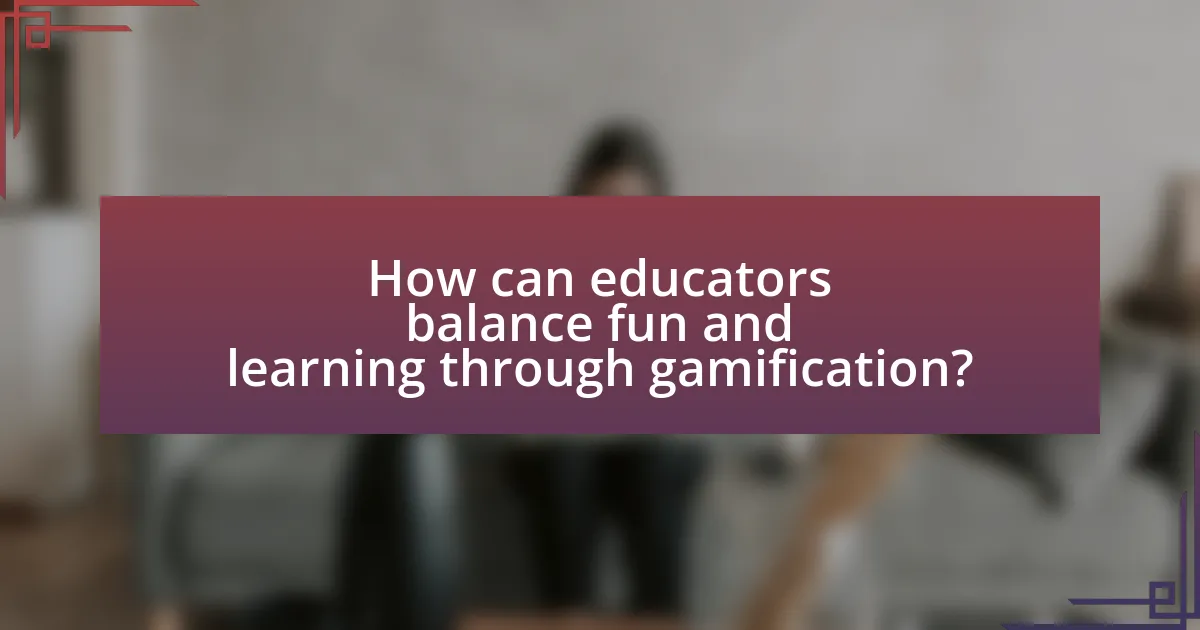
How can educators balance fun and learning through gamification?
Educators can balance fun and learning through gamification by integrating game mechanics that enhance engagement while aligning with educational objectives. For instance, incorporating elements such as point systems, badges, and leaderboards can motivate students and foster a competitive spirit, which has been shown to increase participation and retention of knowledge. Research by Hamari et al. (2016) in “Gamification: Definitions, Benefits, and Challenges” indicates that gamification can lead to improved learning outcomes when designed thoughtfully. By ensuring that game elements are directly tied to learning goals, educators can create an environment where enjoyment and educational value coexist effectively.
What strategies can be employed to ensure educational integrity in gamified environments?
To ensure educational integrity in gamified environments, implementing robust assessment methods is essential. These methods include formative assessments that provide ongoing feedback, summative assessments that evaluate learning outcomes, and the use of analytics to track student progress and engagement. Research indicates that incorporating diverse assessment strategies can enhance learning while maintaining integrity, as evidenced by a study published in the Journal of Educational Psychology, which found that varied assessments lead to improved student performance and accountability. Additionally, establishing clear guidelines and expectations for academic honesty within the gamified framework reinforces integrity, as students are more likely to adhere to standards when they understand the consequences of dishonesty.
How can assessments be designed to complement gamified learning?
Assessments can be designed to complement gamified learning by integrating game mechanics such as points, levels, and badges into the evaluation process. This approach encourages student engagement and motivation, as it aligns assessment with the interactive and rewarding nature of gamified experiences. For instance, formative assessments can be structured as quests or challenges that allow learners to earn rewards for completing tasks, thereby reinforcing learning objectives while maintaining the fun aspect of gamification. Research indicates that gamified assessments can lead to improved retention and understanding of material, as evidenced by a study published in the Journal of Educational Psychology, which found that students who participated in gamified assessments scored significantly higher on retention tests compared to those who underwent traditional assessments.
What role does feedback play in maintaining educational value in gamification?
Feedback is essential in maintaining educational value in gamification as it provides learners with timely information about their performance, guiding their learning process. This immediate response helps students understand their strengths and areas for improvement, fostering a growth mindset. Research indicates that effective feedback can enhance motivation and engagement, which are critical components of gamified learning environments. For instance, a study by Hattie and Timperley (2007) in “Review of Educational Research” highlights that feedback significantly influences student achievement by clarifying learning goals and promoting self-regulation. Thus, feedback not only reinforces learning objectives but also ensures that gamification remains a meaningful educational tool.
How can educators measure the effectiveness of gamification in their teaching?
Educators can measure the effectiveness of gamification in their teaching by utilizing quantitative metrics such as student engagement levels, academic performance, and retention rates. For instance, studies have shown that gamified learning environments can lead to a 20% increase in student engagement and a 15% improvement in test scores compared to traditional methods. Additionally, educators can employ surveys and feedback tools to assess student satisfaction and motivation, providing qualitative data that complements the quantitative findings. This dual approach ensures a comprehensive evaluation of gamification’s impact on learning outcomes.
What metrics can be used to evaluate student learning outcomes in gamified settings?
Metrics used to evaluate student learning outcomes in gamified settings include engagement levels, knowledge retention, skill acquisition, and performance analytics. Engagement levels can be measured through participation rates, time spent on tasks, and frequency of interactions within the gamified environment. Knowledge retention is often assessed via pre- and post-tests, which quantify the amount of information retained after gamified learning experiences. Skill acquisition can be evaluated through practical assessments or simulations that demonstrate the application of learned skills. Performance analytics, such as scores, completion rates, and feedback from peers or instructors, provide quantitative data on student progress and achievement. These metrics collectively offer a comprehensive view of how effectively gamified approaches enhance learning outcomes.
How can qualitative feedback enhance the understanding of gamification’s impact?
Qualitative feedback enhances the understanding of gamification’s impact by providing in-depth insights into user experiences and motivations. This type of feedback captures the nuances of how individuals interact with gamified elements, revealing emotional responses and behavioral changes that quantitative data alone may overlook. For instance, studies have shown that qualitative feedback can identify specific aspects of gamification that resonate with learners, such as competition or collaboration, which can inform the design of more effective educational interventions. By analyzing open-ended responses, educators can better understand the contextual factors that influence engagement and learning outcomes, ultimately leading to more tailored and effective gamification strategies.
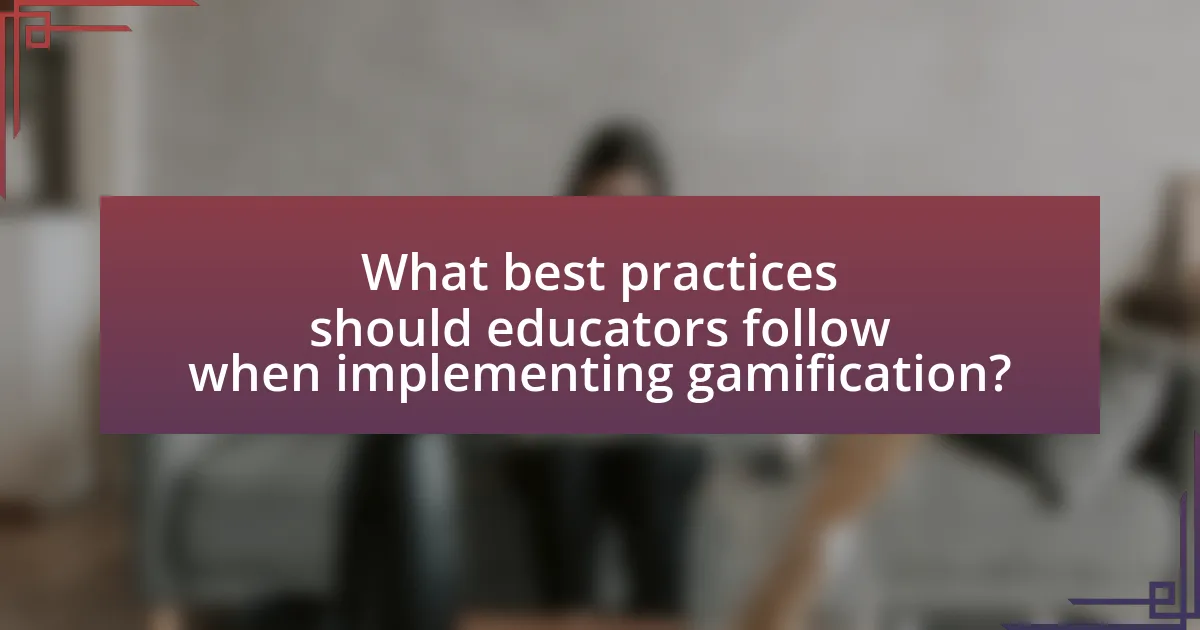
What best practices should educators follow when implementing gamification?
Educators should prioritize clear learning objectives when implementing gamification. Establishing specific goals ensures that game elements align with educational outcomes, enhancing student engagement and motivation. Research indicates that gamification can improve learning retention by up to 34% when objectives are well-defined (Hamari et al., 2014). Additionally, incorporating feedback mechanisms, such as progress tracking and rewards, fosters a sense of achievement and encourages continuous improvement. Studies show that timely feedback can increase student performance by 20% (Hattie & Timperley, 2007). Finally, educators must consider the diverse needs of students, ensuring that gamification strategies are inclusive and accessible to all learners, which can lead to a more equitable learning environment.
How can educators create a balanced gamified curriculum?
Educators can create a balanced gamified curriculum by integrating educational objectives with engaging game mechanics. This approach ensures that learning outcomes are met while maintaining student interest. For instance, incorporating elements such as point systems, badges, and leaderboards can motivate students, but these should align with specific learning goals to avoid distraction from the core content. Research indicates that when game elements are thoughtfully designed to support educational objectives, such as in the study “The Impact of Gamification on Student Engagement and Learning Outcomes” by Hamari et al. (2014), students demonstrate improved engagement and retention of knowledge. Thus, a balanced gamified curriculum effectively combines fun with educational rigor, fostering a productive learning environment.
What elements should be included to foster both fun and learning?
To foster both fun and learning, elements such as engagement, interactivity, and meaningful feedback should be included. Engagement can be achieved through game-like mechanics, such as rewards and challenges, which motivate learners to participate actively. Interactivity allows learners to explore concepts through hands-on activities or simulations, enhancing their understanding. Meaningful feedback provides learners with insights into their progress, helping them to improve and stay motivated. Research by Hamari et al. (2016) in “Gamification: Definitions, Benefits, and Challenges” highlights that these elements significantly enhance the learning experience by making it enjoyable and effective.
How can educators ensure inclusivity in gamified activities?
Educators can ensure inclusivity in gamified activities by designing games that accommodate diverse learning styles and abilities. This can be achieved through differentiated tasks that allow students to engage at their own levels, ensuring that all participants can contribute meaningfully. Research indicates that inclusive gamification strategies, such as providing multiple means of engagement and representation, enhance participation among students with varying needs (CAST, 2018). By incorporating feedback mechanisms and collaborative elements, educators can foster an environment where every student feels valued and included, thus promoting equity in learning experiences.
What common pitfalls should educators avoid in gamification?
Educators should avoid several common pitfalls in gamification, including overemphasis on rewards, lack of clear learning objectives, and neglecting diverse learning styles. Overemphasis on rewards can lead to extrinsic motivation overshadowing intrinsic motivation, which research indicates is crucial for deep learning (Deci & Ryan, 2000). A lack of clear learning objectives can result in confusion among students regarding the educational purpose of the gamified elements, diminishing their effectiveness (Gee, 2003). Additionally, neglecting diverse learning styles can alienate students who may not engage with the gamified content, as effective gamification should cater to various preferences and abilities (Felder & Silverman, 1988).
How can over-reliance on gamification detract from learning objectives?
Over-reliance on gamification can detract from learning objectives by shifting the focus from intrinsic motivation and deep understanding to superficial engagement and reward-seeking behavior. When educational experiences prioritize game mechanics, such as points and badges, learners may become more interested in achieving these rewards than in grasping the underlying concepts. Research by Hamari et al. (2014) indicates that excessive gamification can lead to a decrease in intrinsic motivation, as learners may prioritize completing tasks for rewards rather than for the sake of learning. This shift can result in a lack of critical thinking and problem-solving skills, ultimately undermining the educational goals intended by the curriculum.
What strategies can prevent gamification from becoming a distraction?
To prevent gamification from becoming a distraction, educators should implement clear objectives and align game elements with learning outcomes. By establishing specific goals, students can focus on the educational purpose of gamification rather than getting sidetracked by the game mechanics. Research indicates that when gamification is closely tied to learning objectives, it enhances engagement without detracting from educational content (Deterding et al., 2011). Additionally, providing regular feedback and maintaining a balance between challenge and skill level can help keep students motivated and on task, ensuring that the gamified elements serve to reinforce learning rather than distract from it.
What practical tips can educators use to enhance gamification in their classrooms?
Educators can enhance gamification in their classrooms by incorporating clear objectives, immediate feedback, and collaborative elements into their lesson plans. Clear objectives help students understand the goals of the game and what they need to achieve, which increases motivation and engagement. Immediate feedback allows students to recognize their progress and areas for improvement, fostering a growth mindset. Collaborative elements, such as team challenges or peer reviews, encourage social interaction and enhance learning through shared experiences. Research indicates that these strategies can significantly improve student engagement and learning outcomes, as evidenced by a study published in the Journal of Educational Psychology, which found that gamified learning environments led to higher student motivation and achievement.

